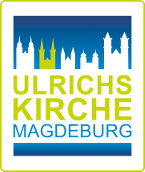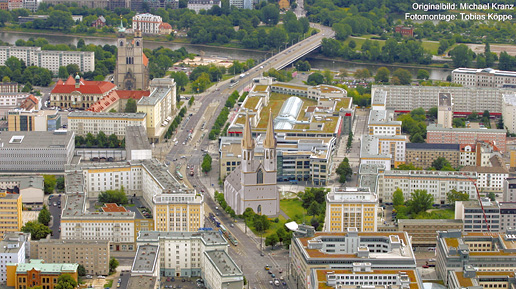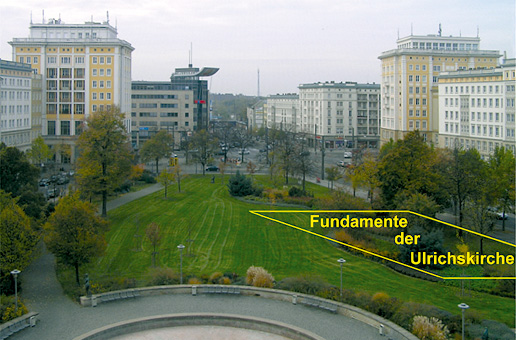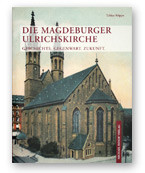
The church of Saint Ulrich and Levin -
a key building in Reformation history
No other City in the world remained as faithful to the message of the Gospels as Magdeburg. The church of St. Ulrich and Levin embodied the progressive, reformative and humanistic ideals of the City and reflected its civic self-confidence. Martin Luther's thoughts were spread all over the world by its community. Therefore it is a key building in world history. Due to communist ideology the church was blown up in 1956.
The church was blown up in 1956
The church of Saint Ulrich and Levin - reformative site of world-historical importance
500 years reformation (1517-2017), over 1000 years church of St.Ulrich and Levin. It used to be Magdeburg's second-oldest church dating between 993 and 1022, most probably 1004. Magdeburg's greatest son, Otto von Guericke, was baptised here.
The church played a very important role in the history of the town, particulary during reformation. Therefore one can say it even played a very important role in the history of Europe, even of the world. St.Ulrich and St. Levin is the only one of the many religious buildings lost to Magdeburg which, even today, could still be reconstructed faithful to the original on its ancient foundations in its original location.
The idea of its reconstruction comes from an insider, from one proud to be a native of Saxony-Anhalt, a long-standing member of the "Magdeburgische Gesellschaft von 1990 e.V.", and it has therefore not been prompted by any outside influence. The Ulrichshaus and the Allee-Center, both built since afer 1989, are low enough to permit a silhouette to be seen from the River Elbe.
The City-Carré, with its diagonally-laid passages, leads the flow of pedestrians directly from the main station to the twin towers of the Ulrichskirche. In terms of urban planning, the Ulrichskirche fits perfectly into its new/old environment. It would welcome train passengers too, and invite them to take a rather closer look at Magdeburg's Altstadt (old town centre).
It would reinforce the attraction of the northern Altstadt as a unique ensemble of Gothic, neo-classic and modern architecture, all in harmony, which would probably be hard to match anywhere in Germany. The two tall buildings at the western edge of the square form as it were the "new" Ulrichstor; the Ulrichshaus stands at the eastern edge of Ulrichplatz, and all that is missing is the Ulrichskirche next to the beloved Ulrich Fountain to complete the reconstruction of the city centre.
The past and the future all in one place! The use of the new building will also be clearly defined - a city centre must offer more than just a shopping mall! Tourism would be encouraged, attention attracted to the City, jobs created, weak points would be improved, the City's self-confidence would be strengthened and the ensemble would act as a magnet for the creative. Architectural features – including reconstructions – play a significant role in the competition between cities to attract attention.
The Ulrichskirche can be reconstructed in a scale of exactly 1:1. What a chance for Magdeburg, what a chance for Saxony-Anhalt, what a chance for Germany!

The Ulrichsplatz with the church of St. Ulrich (aerial view)
The tragical history of the City of Magdeburg
The architecture of the City of Magdeburg has been destroyed at least three times during its history: Firstly on May 10th 1631 during the Thirty Years' war; on January 16th 1945 due to bombing by American warplanes and again after 1949 during the communist rebuilding of the city centre, where eight church ruins which could have been restored were unfortunately destroyed.
Previously Magdeburg was thought to be one of most beautiful cities in Germany with a rich variety of buildings built over its 1200 years of history. Approximately 85 percent of the buildings of the city were destroyed during World War 2, transforming the former "Rome of Germany" into an urban desert, where only ruins were left.
Although it had sustained damage several times over its almost 1000 year history, much of the church was lucky enough to survive the devastating bombardments of the Second World War. Although the roof and the vaults were destroyed by American bombs, the surrounding walls, the choirmaster and the twin towers survived. The church then remained a ruin for eleven years following the war and although it could have been restored, was demolished in April 1956 against national and international protests.
The church stones were moved to the zoological garden in the city and the foundations were grassed over. At that time it was envisaged that a modern concrete skyscraper would be built on the site. The vision of a modern skyscraper was never realised and now Ulrichplatz is a large urban space devoid of atmosphere or architectural merit. The destruction started by the American bombs was finished up by communist ideology.

Inclusion of the church of St. Ulrich in the rebuilding of the town during the fifties
A tangible testimony for liberty and tolerance
The church of St. Ulrich was shelter and testimony for freedom of thought again and again. In the times of "Our Lord's Office" Protestant ideas were distributed from there - "Protestant" means to protest against secularization and abuses of the church of those times and to confess true faith based only on the Holy Bible. In the "Third Reich" the church of St. Ulrich belonged to the Confessing Church, the part of the German Evangelical church expressively being in opposition to the unjust and inhuman national socialist ideology. During the time of atheist and antireligious socialism the church was blown up purely for ideological reasons in order to enforce the unfree and constricting state ideology of Marxism-Leninism. Therefore all traces of ecclesiastical buildings and religious life had to be banned from the "modern" socialist cityscape.
Thus the church won't become only a "new" parochial church but also an interdenominational and interreligious cultural centre and symbol of freedom of thought and tolerance as well as a memorial against fundamentalism and fanaticism of all kind. Furthermore, it should be noted that the church cannot become and shouldn't become a parochial church in the classical sense but should be of multiple use as "Citykirche" (a kind of pastoral care in city centres), library, museum. exposition hall, cultural centre and memorial simply because all Christians of all denominations at Magdeburg form a small minority and live all together in a Diaspora - over eighty percent of the local population don't belong to any church or religion.
Thus we are aware of the objections against the reconstruction of the church raised by the above-mentioned reasons. Therefore the church of St. Ulrich shouldn't primarily represent a single denomination but should keep alive the spirit of the world wide diversity and plurality of world views, religions, mindsets and life concepts.
The Ulrichsplatz with the church of St. Ulrich
The idea of reconstructing the church of Saint Ulrich and Levin on its old foundations
Reconstructing old buildings on their original foundations is not a new idea. The astonishing success of the reconstruction of the Church of Our Lady in Dresden shows the desire of the German people for compensation of the massive loss of historical buildings in and after World War 2.
Such historical buildings give identity to the people. In many German cities several important historical buildings already have been reconstructed (Dresden: Church of Our Lady, Braunschweig: Castle) or are in the planning stages of reconstruction (Potsdam: Garnisonkirche, Berlin: Castle, Leipzig: Church of St.Pauli). Elsewhere, successful reconstructions on old foundations can be seen in many Polish cities (Warsaw, Stettin, Elbing) or even in Moscow (Church of Jesus Christ), showing that reconstruction is possible and acceptable. The lack of post war development on this site still offers the opportunity to rebuild the church at its original place on its old foundations.

Original ancient place of the church
Including its apron, the church building itself would take up no more than one-fourth of the green area of the Ulrichplatz. Neither the fountain to one side, nor the Ernst-Reuter-Allee and the footpath on the other would be affected.
The attractiveness of the northern Altstadt would be enhanced and a unique ensemble of Gothic, neo-classic and modern architecture, all in harmony, would be created, which would probably be hard to match anywhere in Germany.
Following the loss of the eight churches mentioned above, the Magdeburg skyline with its typical twin towers has thinned out dramatically. Reconstructing the church would help rebuild the old city skyline. The silhouette between St.Johannis and the cathedral would finally be complete. The reconstruction of the church of St.Ulrich could help compensate for the devastating destruction the City has endured in the past.
This internet site wants to gather people all over the world, who regret the destruction of this beautiful building and who are keen to support our plan to reconstruct it. Join us! The society for support of reconstructing the church of St.Ulrich in Magdeburg needs your help.
The managing commitee of the Kuratorium Ulrichskirche e.V. on October 31st, 2022 (15th birthday)
Magdeburg's first citizen's referendum - a referendum precisely against a church
A citizen's initiative was directed against a resolution of the municipal council of June 24, 2010 that offered the Kuratorium Ulrichskirche e. V. keeping free and supplying the original site for the reconstruction of the church of Saint Ulrich under the condition that a sustainable financial and utilization concept will be presented beforehand. This initiative also was successful in collecting at least 10,000 valid signatures and thus met the requirement for a referendum.
During its campaigns - e. g. in a newspaper advertisement in the local paper "Magdeburger Volksstimme" - the opposing citizen's initiative used a prohibition sign showing a crossed-out church. This symbol was shown in spite of many protests and in spite of several demands by the Kuratorium Ulrichskirche e. V., by the German Christian Democrats (CDU) and by the Young Liberals not to use this sign; by doing that the initiative repeatedly offended religious feelings of the Christian population of the town in a severely intolerant way. Such prohibition signs do not at all belong in an open, modern and tolerant society. According to Article 4 section 1 of the German Basic Law (the German Constitution) the freedom of belief, the freedom of conscience and the freedom of religious and ideological confession are inviolable.
Quoted from: Magdeburger Volksstimme of March 19, 2011
The first referendum in the history of Magdeburg on March 20, 2011 with a number of 198,203 citizens eligible to vote caused a good above-average turnout of 56.32 percent. The referendum question "Are you against the reconstruction of the Magdeburg church of Saint Ulrich?" was answered with "yes" by 76.05 percent of the voters and with "no" by 23.95 of the voters. To make things clear: 76.05 percent of all Magdeburg voters elect against the reconstruction of the Magdeburg church of Saint Ulrich, 23.95 percent elect in favour of the reconstruction. Thus 26.470 people in Magdeburg have voted in favour of the reconstruction of the church of Saint Ulrich. 43.68 percent of all citizens eligible to vote didn't take part in the referendum. The result of this referendum was legally binding on the municipal council for a period of two years. Since March 2013 the municipal council is free to make new decision to the topic and did this already on Februar 23, 2017, on Oktober 11, 2021 and on February 22, 2022. Most recently, there was an application to expose parts of the foundations of the Ulrichskirche. Unfortunately, in the end, one vote was missing in the city council vote for the uncovering. Even the reconstruction of the portal could not find a majority in the city council. However, we are not discouraged and continue to promote approval.
Church of Saint Ulrich - Quo Vadis?
Even if we are aware that in Magdeburg only nine percent of all inhabitants belong to the Protestant Churches (Lutheran and Reformed Church), four percent belong to the Roman Catholic Church and one percent are members of other denominations or religions - this particularly caused by the history of German Democratic Republic (GDR) - thus about 86 percent of all Magdeburg inhabitants being irreligious or nondenominational - and even if it seems as if the reconstruction of the church of Saint Ulrich might have been clearly rejected by the referendum the following should be kept in mind:
The number of supporters of such a project is growing steadily and inexorably. Initially in times when the association was founded only few persons - mainly the founding members of the Kuratorium - could be encouraged into the idea of the reconstruction. Gradually the number increased to some hundred persons - now not only more and more members joining the Kuratorium but also a growing quantity of citizens. Then there were some thousand supporters documented by the numerous signatures on our signature lists. Now in the referendum 26.470 people have voted for a reconstruction! We have succeeded in rescuing the church of Saint Ulrich from oblivion to which it was consigned by the ideologically motivated blowing-up and by the following repression of the whole theme during socialist history of the GDR.
Particularly right now we will continue our efforts and explore the topic of the church of Saint Ulrich in a more detailed and deepened way. Probing, explorations and excavations will be effective methods which will surely bring highly interesting aspects of the over thousand year's history to surface. Scientific works and research aren't prohibited by the result of the above-mentioned referendum. The gained results will certainly, too, lead to the situation that awareness of the Magdeburg inhabitants of the church will steadily raise and that opposition among the population will continuously diminish.
We therefore ask you right now more than ever for support especially in our upcoming scientific research tasks.
Please help us, too, with a donation!
Please support us with donations which will at present allow us to continue our association' s daily work, to finance first archaeological excavations, to establish a foundation and finally to rebuild the church of St. Ulrich.
Bank details:
Bank: Deutsche Bank Magdeburg
Account number: 120804000
Bank code, to be used only in case of payment from German accounts: 810 700 24
IBAN: DE21810700240120804000
SWIFT/BIC: DEUTDEDBMAG
Bank: Stadtsparkasse Magdeburg
Account number: 32254500
Bank code, to be used only in case of payment from German accounts: 810 532 72
IBAN: DE63810532720032254500
SWIFT/BIC: NOLADE21MDG
Please specify the addressee of the payment as following: "Kuratorium Ulrichskirche e.V.". A reason for payment needn't be indicated because the accounts are special donation accounts. Donations are tax deductible according to German tax legislation. Please inform yourself about tax handling of donations in your home country. The donation receipt will be sent to you (in German language) by the end of a quarter. For this purpose please give us your address. Please inform us, too, if you don't need a donation receipt at all or if you need a receipt in English or with particular details.
"Thank you very much!" says Dr. Tobias Köppe, chairman of the Kuratorium Ulrichskirche e. V. (at right)
Eleven reasons for the reconstruction of the church of St. Ulrich and Levin
- key buildung in Reformation history due to the worldwide spreading of Martin Luther's ideas
- church of baptism and marriage of Otto von Guericke, the greatest son of the city
- used to be the most beautiful one in Magdeburg, one of the most beautiful ones in Germany
- second oldest church of Magdeburg, dedicated to Ulrich of Augsburg, closest friend of emperor Otto I.
- gives Ulrichplatz its name
- improves the urban quality of the city centre
- interesting tourist attraction
- rebuilding the old famous skyline with its typical twin towers
- helps make up for the loss of eight churches due to fascist and communist regimes
- church can be rebuilt on its old foundations
- the only reconstruction in Gothic-Roman style worldwide
Special thanks to David Moore (Brunswick) for helping with the translation.
Send an e-mail with questions or comments on this website to info@ulrichskirche.de
Society:
- Kuratorium Ulrichskirche e.V.
"Aber woher sollten das die Wähler wissen? Hätten sie es gewusst und anders abgestimmt, wäre Magdeburg jetzt jährlich das Ziel von zigtausenden US-Touristen und 2025 sicher Kulturhauptstadt Europas." Siegfried Kolberg, Magdeburg






